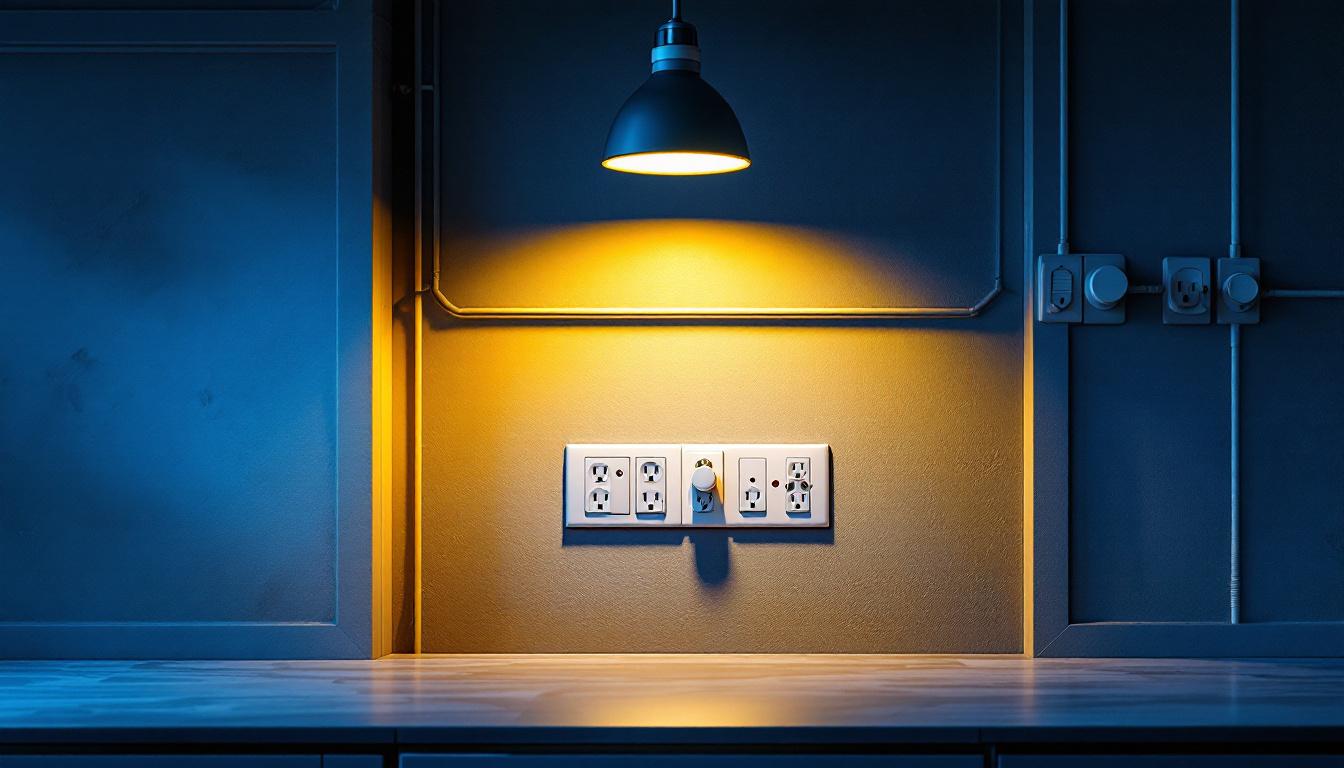
When it comes to commercial lighting, understanding the intricacies of electrical outlets is crucial for lighting contractors. The right outlets ensure that lighting systems function efficiently and safely, providing the necessary illumination for various commercial spaces. This article delves into the essential aspects of commercial electrical outlets, focusing on their types, installation, and safety considerations.
Commercial electrical outlets come in various types, each designed to meet specific needs and applications. Understanding these types is essential for contractors to choose the right outlet for their lighting projects.
Standard outlets, commonly known as duplex outlets, are the most familiar type of electrical outlet. They typically provide 120 volts and are suitable for general lighting and small appliances. In commercial settings, these outlets are often used in offices, retail spaces, and other environments where standard lighting fixtures are employed.
For lighting contractors, it’s important to consider the load requirements of the lighting fixtures being installed. Standard outlets can handle a moderate amount of wattage, making them ideal for LED lights and other energy-efficient options. However, they may not be suitable for high-wattage fixtures, which require more specialized outlets. Additionally, the placement of standard outlets should be strategically planned to accommodate the layout of the space, ensuring that they are easily accessible for use without causing clutter or obstruction.
Ground Fault Circuit Interrupter (GFCI) outlets are designed to protect against electrical shocks by shutting off power when they detect a ground fault. These outlets are essential in areas where water and electricity may come into contact, such as bathrooms, kitchens, and outdoor spaces.
For lighting contractors, installing GFCI outlets in commercial settings is not just a safety measure; it is often a code requirement. Ensuring that all lighting fixtures in wet or damp locations are connected to GFCI outlets can prevent accidents and enhance the overall safety of the installation. Furthermore, GFCI outlets often come equipped with a test and reset button, allowing users to easily check the functionality of the outlet and ensure it is working properly, which is particularly important in high-traffic areas where safety is a top priority.
Specialty outlets cater to specific needs and applications. Examples include 240-volt outlets for high-wattage equipment and outlets with additional features, such as USB ports for charging devices. These outlets are becoming increasingly popular in commercial environments where versatility and convenience are paramount.
When selecting specialty outlets, contractors should assess the lighting requirements and any additional equipment that may need to be powered. This ensures that the electrical system can handle the load without overloading circuits or causing potential hazards. Moreover, with the rise of smart technology in commercial spaces, outlets that support smart devices and automation systems are also gaining traction. These advanced outlets can help streamline operations and improve energy efficiency, allowing businesses to adapt to the ever-evolving technological landscape while meeting the demands of modern consumers.
Proper installation of electrical outlets is critical for the safety and functionality of commercial lighting systems. Several factors must be considered to ensure that outlets are installed correctly and comply with local codes.
The placement of electrical outlets is vital for both functionality and safety. Outlets should be installed in accessible locations, allowing easy access for plugging in lighting fixtures and other equipment. In commercial spaces, this often means placing outlets at strategic points along walls or in ceilings, depending on the type of lighting being installed.
Additionally, contractors should consider the layout of the space. For example, in large open areas, it may be necessary to install multiple outlets to ensure that all lighting fixtures can be powered efficiently. Planning the outlet locations during the design phase can save time and reduce complications during installation. It is also important to consider the potential for future modifications to the space; installing outlets in flexible configurations can accommodate changes in lighting needs or the introduction of new technologies without requiring extensive rewiring.
Adhering to local electrical codes is non-negotiable for lighting contractors. These codes dictate the standards for electrical installations, including outlet types, placement, and safety measures. Failure to comply can result in fines, project delays, and even safety hazards.
Contractors should familiarize themselves with the National Electrical Code (NEC) and any local amendments that may apply to their projects. This knowledge will help ensure that all electrical outlets are installed correctly and safely, providing peace of mind for both the contractor and the client. Furthermore, engaging with local electrical inspectors early in the project can provide valuable insights and help identify any specific requirements that may not be immediately apparent, ensuring a smoother inspection process once the installation is complete.
Before installing electrical outlets, it is essential to perform load calculations to determine the appropriate outlet type and circuit requirements. This involves assessing the total wattage of the lighting fixtures and any other devices that will be connected to the outlet.
Using the formula: Total Wattage = Voltage x Amperage, contractors can ensure that the outlets are not overloaded. Overloading can lead to tripped breakers, damaged equipment, and potential fire hazards. By accurately calculating the load, contractors can select the right outlets and circuits to support the lighting system. It is also advisable to include a safety margin in these calculations, allowing for any unexpected increases in load due to future equipment additions or changes in usage patterns. This proactive approach not only enhances safety but also extends the lifespan of the electrical system, reducing the likelihood of costly repairs or replacements down the line.
Safety is paramount in any electrical installation, especially in commercial settings where large crowds may gather. Understanding the safety considerations associated with electrical outlets can help prevent accidents and ensure compliance with regulations.
Electrical surges can cause significant damage to lighting systems and other connected equipment. Installing surge protectors at the outlet level can help mitigate this risk. Surge protectors work by diverting excess voltage away from the connected devices, protecting them from damage.
For contractors, recommending surge protection for commercial lighting installations is a proactive approach to safeguarding the investment. It can also enhance the longevity of the lighting fixtures and reduce maintenance costs over time.
Regular inspections and maintenance of electrical outlets are essential to ensure their continued safety and functionality. Contractors should encourage clients to schedule periodic checks to identify any signs of wear, damage, or malfunction.
During inspections, look for loose connections, discoloration, or any unusual smells coming from the outlets. Addressing these issues promptly can prevent more significant problems down the line and ensure that the lighting system remains safe and effective.
Training and education are vital for lighting contractors to stay updated on the latest safety practices and electrical codes. Participating in workshops, seminars, and online courses can enhance knowledge and skills, ensuring that contractors are well-equipped to handle various lighting projects.
Additionally, educating clients about the importance of electrical safety and proper outlet use can foster a culture of safety within commercial spaces. This proactive approach can help prevent accidents and ensure that all lighting installations meet the highest standards of safety and efficiency.
The landscape of commercial electrical outlets is continually evolving, driven by advancements in technology and changing consumer demands. Staying informed about these trends can help lighting contractors remain competitive and provide the best solutions for their clients.
Smart outlets are becoming increasingly popular in commercial settings, offering enhanced control and automation for lighting systems. These outlets can be connected to smart devices, allowing users to control lighting remotely through smartphones or voice-activated systems.
For lighting contractors, integrating smart outlets into lighting designs can provide clients with added convenience and energy efficiency. This technology allows for features such as scheduling, dimming, and energy monitoring, making it an attractive option for modern commercial spaces.
As sustainability becomes a priority for many businesses, energy-efficient electrical outlets are gaining traction. These outlets are designed to minimize energy consumption, reducing overall operational costs for commercial spaces.
Contractors should stay informed about the latest energy-efficient technologies and consider incorporating them into their lighting designs. This not only benefits the environment but also appeals to clients looking to reduce their carbon footprint and operational expenses.
With the increasing focus on safety, manufacturers are developing electrical outlets with enhanced safety features. Innovations such as tamper-resistant outlets and built-in circuit breakers are becoming standard in commercial installations.
Contractors should prioritize these safety features in their projects, ensuring that all electrical outlets meet the highest safety standards. This commitment to safety will not only protect clients but also enhance the contractor’s reputation in the industry.
Understanding commercial electrical outlets is essential for lighting contractors aiming to deliver safe, efficient, and effective lighting solutions. By familiarizing themselves with the various types of outlets, installation considerations, and safety measures, contractors can ensure that their projects meet the highest standards.
As the industry continues to evolve, staying informed about future trends and innovations will enable contractors to provide cutting-edge solutions that meet the needs of their clients. Ultimately, a strong grasp of commercial electrical outlets will contribute to the success and safety of any lighting project.
Ready to elevate your lighting projects with the highest quality electrical outlets and fixtures? Look no further than LumenWholesale, where we provide contractors with spec-grade lighting products at unbeatable wholesale prices. Our extensive selection is designed to meet the most rigorous industry standards, ensuring you have access to reliable and high-performance lighting solutions for every commercial space. Plus, with the convenience of free shipping on bulk orders, you can secure premium lighting at the best value without any hidden fees or compromises. Don’t let inflated markups dim your project’s potential. Wholesale Lighting at the Best Value is just a click away. Experience the LumenWholesale difference today!

Discover the pitfalls lighting contractors often encounter when installing LED lights for track lighting.

Discover the ultimate guide for lighting contractors seeking reliable LED strip suppliers.

Discover the frequent pitfalls lighting contractors encounter with 8ft fluorescent bulbs.

Discover the importance of waterproof landscape lighting in outdoor installations.